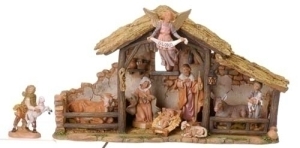Sunday Musings
 On Friday night, I had the privilege of sitting with one of my neighbors at the showing of The Nativity Story at Trinity Church. It is a very good movie, remarkable for Hollywood. It treats the birth of Christ with respect and gritty honesty. It does use some literary license in mostly innocuous ways and in some ways that continue long held tradition with little biblical evidence.
On Friday night, I had the privilege of sitting with one of my neighbors at the showing of The Nativity Story at Trinity Church. It is a very good movie, remarkable for Hollywood. It treats the birth of Christ with respect and gritty honesty. It does use some literary license in mostly innocuous ways and in some ways that continue long held tradition with little biblical evidence.
On Saturday, I ran across an article that purported to expose “Five Christmas Myths.” Here’s my take on both that article and the movie THE NATIVITY STORY as it relates to some Christmas misconceptions.
- Were there three kings? Probably not. What about three wise men? Maybe. The visitors from the East that get memorialized in our songs, (“we three kings of orient are …”) and our Christmas manger scenes were not kings. They are called “magi” (Gr. μαγοι) in the Scripture (Mt. 2:1). The word is associated with advisors and wise men from the East who studied the stars. Perhaps the number three is suggested by the gifts of gold, frankincense, and myrrh, that are mentioned in Matthew 2:11. We know there was more than one, we don’t know that there was more than two but the number of gifts suggest three. Also, in the Scripture, none of their names are given so all of the names that tradition has assigned them are made up, even the ones in the movies.
dddd - How many baby boys lost their lives to Herod’s attempt to defeat prophecy? Unknown, but probably less than 10 and maybe less than half that. The horrors of that night for the families of Bethlehem are incalculable but the village was quite small in the first century and it is unlikely that the number of children were large. The whole episode is a reminder of the suffering that all Israel suffered down through the ages for the privilege of being the instrument through which God would redeem the earth.
ddddd - The virgin birth. The virgin birth that is hinted at in Luke 3:23 and explicitly referred to in Luke 1:30-34 (cf. also Mt. 1:18-25) might be better understood as a virginal conception. Mary is a virgin, yes, who conceives by the will of God according to the miraculous working of God’s Spirit. Jesus is fully human but also fully God.
dddd - Why do we celebrate Jesus birth on December 25th? The actual date of Jesus birth is unknown. Here’s a brief discussion from Frank Viola website on the topic:
Jesus was born “before Christ” (B.C.). Probably 4 or 5 B.C. As for His birthday being December 25th, this is unlikely. For the church’s first three centuries, the Lord’s birth wasn’t celebrated in December. If it was observed at all, it was lumped in with Epiphany on January 6th. While it’s possible that Jesus was born in the winter, this is uncertain. In short, the exact day of Jesus’ birth is unknown.
It is for this reason that the early Christians ended up confiscating a pagan holiday to celebrate the Lord’s birth, thus redeeming the day – December 25th – for Christ. The early writers of the church disagreed on the Lord’s birth date. Some like Clement of Alexandria argued that He was born on May 20th. Others like Hippolytus argued He was born on January 12. Other proposed dates were March 21, March 25, April 18, April 19, May 29, November 17, and November 20. The eventual choice of December 25th was chosen as early as A.D. 273.
Here’s a nice little Bible study for you:
- Analyze the texts surrounding the birth of John the Baptist (Luke 1:5-25).
- Knowing that Mary is pregnant during Elizabeth’s 6th month, can you figure out a likely time frame for the birth of Christ?

Always good to see a balanced treatment of the subject, as opposed to pure sentimentalism at one end and sensationalist exposures of “the pagan roots of Christianity!” at the other. Thanks, Marty!
LikeLike
Thanks Mitch. It is tiresome to hear so many trash ALL tradition that is not explicitly biblical sometimes. We need to be accurate and big-hearted. For some time I have thought about putting up a Santa Claus on my front lawn, with a sign that said, “a harmless and pleasant tradition.” Then a week later put up a nativity scene, with a sign “the powerful and awesome truth.”
LikeLike